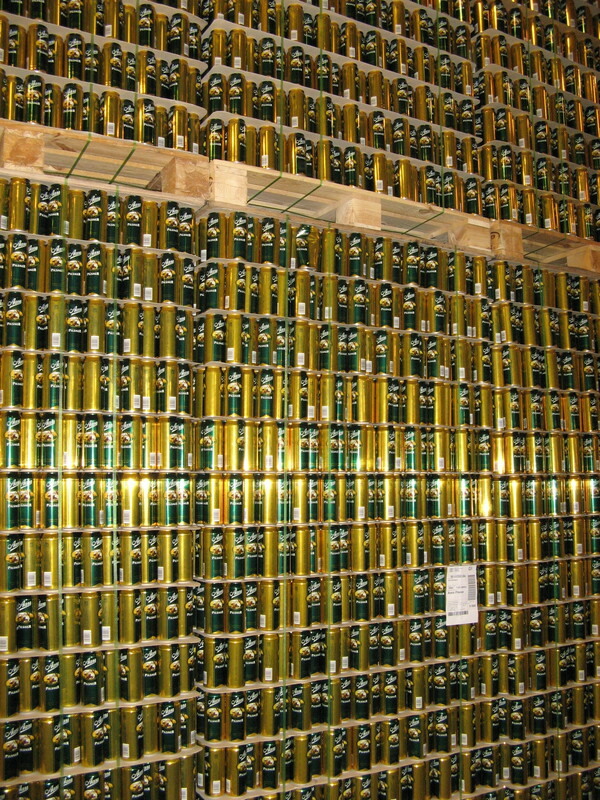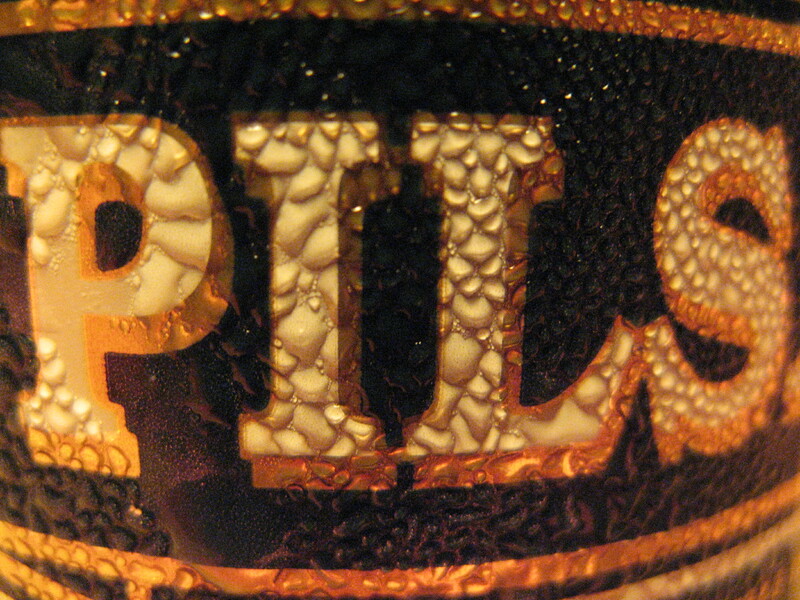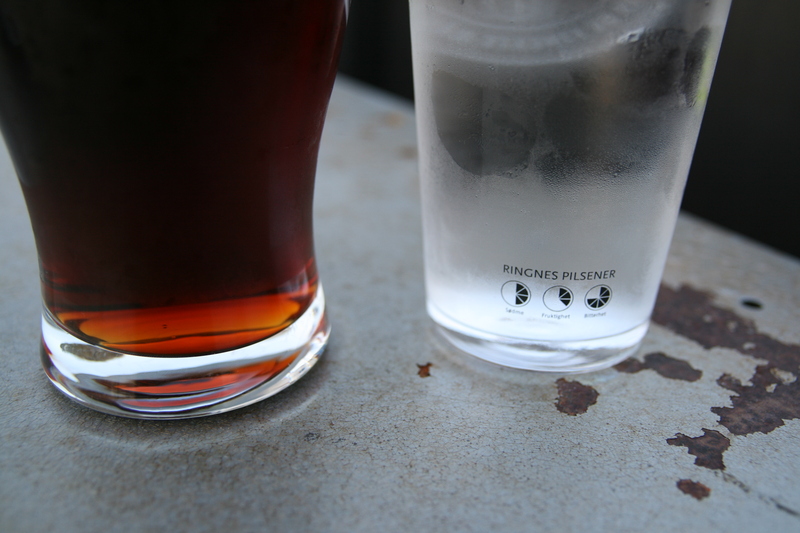The best Norwegian breweries

Oslo Mikrobryggeri Bitter, at the brewpub |
I did another post on this subject back in May 2006, but since then I have done lots more ratings of Norwegian beer, and a number of new breweries have appeared, and so it seems about high time to revisit the subject. The basis of this overview is 320 ratings of Norwegian beers, starting in September 2005 and ending yesterday.
The table was produced by downloading my ratings in a CSV from RateBeer, and then using a Python script to compute the averages. My RateBeer ratings include ciders and perries (pear ciders), but I've filtered those out, since we're really interested in beer here, and not other kinds of products.
So, without further ado, here is the table. The "New" column has the number of new ratings from the brewery since the previous posting. If empty, the brewery is new this time around. The "Change" column has the change to the average since the previous posting.
| Brewery | Average | Ratings | New | Change |
|---|---|---|---|---|
| Nøgne Ø | 3.73 | 22 | +13 | -0.16 |
| Haandbryggeriet | 3.61 | 17 | +10 | -0.08 |
| Ølve på Egge | 3.6 | 3 | ||
| Valdres Gardsbryggeri | 3.45 | 2 | ||
| Lillehammer Bryggeri | 3.45 | 4 | ||
| Møllebyen Mikrobryggeri | 3.27 | 14 | ||
| Ægir Bryggeri | 3.21 | 6 | ||
| Oslo Mikrobryggeri | 3.19 | 13 | +9 | -0.10 |
| Trondhjem Mikrobryggeri | 3.12 | 7 | ||
| Dalane Brygghus | 3.1 | 4 | ||
| Kalfaret Brygghus | 2.95 | 4 | ||
| Aass | 2.94 | 33 | +21 | -0.05 |
| Berentsens Brygghus | 2.92 | 9 | +7 | -0.77 |
| Mack | 2.77 | 27 | +19 | -0.12 |
| Inderøy Gårdsbryggeri | 2.71 | 6 | ||
| Lervig Aktiebryggeri | 2.68 | 5 | ||
| Små Vesen Bryggeri | 2.68 | 5 | ||
| Hansa Borg | 2.56 | 40 | +19 | -0.13 |
| Ringnes | 2.49 | 58 | +22 | -0.00 |
| Grans | 2.04 | 20 | +12 | -0.15 |
| Trio | 1.93 | 3 |
The first thing to note is the number of new breweries. Two years ago I had 10 breweries in the list, while this time around there are 21. (Two brewers, Atna and Baatbryggeriet, have gone out of business in the meantime, and are not in the table.) Of the 12 new breweries, 5 are genuinely new, and 7 existed in 2006 without me having been able to find any of their beers.

Industrial beer en masse, Drammen, Norway |
Another thing to note is that all the brewers (except Ringnes) have seen their average decline since 2006. This is probably because my ratings are now stricter than they were back then. The declines are pretty small, however, so I don't consider this a real problem. (Berentsen is an exception, but this is because in 2006 I'd only rated 2 of their best beers, and have since added 7 more, of which most are boring pilseners.)
As in 2006 the table divides almost completely into craft breweries at the top, and industrials at the bottom. Aass is the first industrial (as in 2006), and below it are all industrials, except for Inderøy and Små Vesen, which are craft breweries.
Craft brewers
Nøgne Ø and Haandbryggeriet take the first two spots, just as they did in 2006, and in my opinion (which I think is generally shared) this is entirely right. The gap between them has closed a little, which is also fair, given that Haandbryggeriet has both improved their beers and started brewing more adventurous beers.
Having Ølve på Egge and Valdres Gardsbryggeri in third and fourth place respectively may not be entirely right, I have to confess, but note that they only have 3 and 2 beers each. Both are older Norwegian micros, each with its own very distinctive style. Ølve makes beers that are rather like the traditional Norwegian farm ales which predate the introduction of lager beers, while Valdres Gardsbryggeri make mild versions of the best-known English beer styles. Both are very hard to find.
Lillehammer Bryggeri is a brewpub that started last year. They have only shop strength beers, which for the moment are only sold in the brewpub. We visited them earlier this year. They are certainly every bit as good as Valdres, and probably better.
Møllebyen Mikrobryggeri is a brewpub in Moss I wrote about in 2006 and again in 2007. The brewery got a new brewer in late 2006, and since then the beers have improved considerably. Their beers are good, but generally very mild to cater to the local audience, and this has probably depressed their ranking somewhat.
Ægir Bryggeri is another brewpub that was started last year in Flåm, in the heart of the fjord country, by American Evan Lewis. The six shop strength beers that have been distributed so far have been very competent US-style beers, and I'm really looking forward to trying some stronger beers from this brewery. The pub itself is also quite spectacular, as is its location, so another trip there (it's just my luck to have been in Flåm twice right before they opened) would also be nice.
Oslo Mikrobryggeri and Trondheim Mikrobryggeri are two brewpubs owned by the same company, which make quite similar beers, mostly English beer styles. Their beers are not bad, but could certainly be better, and I feel they belong here, near the bottom of the craft part of the table.
Dalane Brygghus is a new micro brewery from southwestern Norway, and so far I've only tried find four of their beers (procured through beer friends). Two of these were near the mean in the table, one was well above, and one was well below. So it's a bit early to say definitively whether they are in the right spot in the table or not. I look forward to trying more of their beers.
Industrial brewers

Norwegian beer |
Above I implicitly said that Kalfaret Brygghus was a craft brewery, but this is disputable. Kalfaret is a brewpub opened in the old Hansa brewery by Hansa (see below), and while their beers are mostly English-style ales they are certainly brewed in an industrial interpretation of these styles. So I would probably on balance consider them industrial, and I'm reasonably happy with their position in the table.
Aass is one of the big five remaining traditional industrial brewers, but one that has stuck to its principles as a maker of relatively high-quality traditional industrial lagers. They have a number of uninteresting products, as well as a few quite good ones. Unlike in 2006 I'm now pretty sure I consider them the best of the industrials, and I think they belong where they are in the table.
Berentsens Brygghus is a small family-run brewery in southwestern Norway that is actually over a century old. As with Aass, their portfolio consists of both less interesting beers and some really good ones. I particularly liked the Christmas beer they introduced last year. Like Aass, they are a quality industrial producer, and I think they belong about where they are.
Mack is another of the big five remaining traditional industrial brewers, and has an additional claim to fame through being the northernmost brewery in the world. They are also a quality industrial, although in my opinion not quite as good as Aass.
Inderøy Gårdsbryggeri is a new micro craft brewer, producing only shop-strength beers, and their ratings have suffered a bit for that. So far their ratings have been mostly middling, but as they start hitting their stride I'd expect them to creep up the list a bit.
Lervig Aktiebryggeri is a small industrial brewer from the Stavanger area, started in 2003 in protest against the acquisition of the local industrial brewer. Unfortunately, it was decided to replace a worthless industrial brewer with a slightly more worthy industrial brewer, and so for people who care more about the taste than where the beer is made this was not much of a step forward at all.
Små Vesen is another new micro craft brewer. The name literally means "Little Creatures", and hints at the old folk belief that little fairy creatures were responsible for the fermentation of beer. Their head brewer actually has a degree in wine production, and perhaps because of this their brews are much drier and more acidic than what is usual, which does not agree with everyone. In addition they have—ironically, given the name—had problems with infections, which has hurt their ratings even more. This is another craft brewer I expect will do better once they have settled in properly.
Hansa Borg is the second biggest national brewer. Their products might perhaps be marginally better than those of the next entrant, Ringnes, which is the biggest national brewer. Ringnes does have a few quite good products, but most products from both breweries are better passed over in silence.
Grans is another of the big industrial brewers, but was started in opposition to the market dominance of the traditional brewers. Grans's selling point is the price of their products, which is low. Unfortunately, the ratings are likewise low (notice the distance up to Ringnes). I find that most of their products have a recognizable rubbery grainy character to them, and prefer to pay a bit more for my beers.
Trio is a small regional industrial, now owned by Mack, which has managed to achieve the rather dubious distinction of scoring even lower than Grans. I think I shall be kind to them and not say any more.

Pilsener is water |
Missing brewers
There are actually some Norwegian breweries missing from the above list, but now we are getting into the seriously obscure breweries, where you basically need a car and a couple of days off to be able to get hold of any of their products. The missing ones are:
- Det Lille Bryggeri, craft, 2 beers
- Mo Laksegard, brewpub, 3 beers
- Nordkapp Mikrobryggeri, brewpub, 1 beer
There exist a couple of even smaller breweries, in tourist cabins in the high mountains and so on, but I'll pass over those for now.
Conclusion
In summing up, I think it's fair to say that Norwegian brewing has made great strides forward in the two years since my last overview. We have five new craft breweries, and have lost only two. The distribution of the beers from the craft breweries has improved substantially, so that it's now possible to get hold of beers from most of the craft breweries in Oslo.
The main thing that remains now is for the Norwegian public to wake up to the fact there exists beer other than poor industrial pale lager, but this process is likely to take several years still.
Similar posts
A review of Norwegian brewers
I've been reviewing beers on RateBeer.com for a while now, especially Norwegian beers, and thought it might be interesting to take a look at how the different Norwegian brewers have fared in my ratings
Read | 2006-05-02 20:50
Are macro lagers really all the same?
Beer enthusiasts like to say that people who argue over which industrial pale lager is best are missing the point, because they all essentially taste the same, and none of them are very good, anyway
Read | 2011-05-08 16:23
Norwegian craft beer production
Following my analysis of the Norwegian craft beer market some people were wondering what the graph of total craft brewery output would look like
Read | 2013-02-17 11:14
Comments
Anthony Geving - 2008-08-09 18:00:49
I just moved to Norway this summer from the US. I have been a beer enthusiast and home brewer for many years. Naturally, I was disappointed with the drab, mild beers they refer to as Pilsner that I have tried.
There have been a couple exceptions, Aass Gourmet Pale Ale is a nice English style ale. They also make a respectable Bayern and an ok Pilsner. The other industrial brewers dont come close in my opinion. The smaller breweries you mentioned I have not tried yet but look forward too.
Thanks for the info, AG
Boak - 2008-08-26 04:51:37
Thanks for this - a useful beginners guide to Norwegian beers!